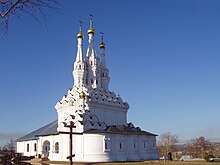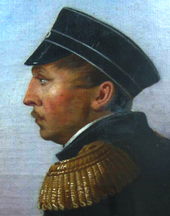Vyasma
| city
Vyazma
Вязьма
|
||||||||||||||||||||||||||||||||||||||||||
|
||||||||||||||||||||||||||||||||||||||||||
|
||||||||||||||||||||||||||||||||||||||||||
| List of cities in Russia | ||||||||||||||||||||||||||||||||||||||||||
Vyazma [ ˈvʲazʲmə ] ( Russian Вя́зьма , scientific transliteration Vjaz'ma ) is a Russian city in the Smolensk Oblast in the west of the country. It is about halfway between Smolensk and Moscow . Vyazma has 57,101 inhabitants (as of October 14, 2010).
history
The first fortress on the site of today's Vyazma was built in the 12th century. Vyasma is first mentioned as an independent place in documents from 1239. This year is now also accepted as the year the city was founded. The name Wjasma is possibly derived from the verb wjasat - in German to bind, to connect - which can be traced back to the location of Wjasma at a connection on the waterway from Scandinavia to Byzantium , namely on the river Vjasma .
In the middle of the 13th century, Vyazma became the center of a Russian principality. In 1403 the place was taken by the Grand Duchy of Lithuania . After several unsuccessful attempts on the part of Moscow to recapture Vyasma, this was not achieved until 1493 under Tsar Ivan III . The place developed rapidly over the next few decades, and numerous boyar residences were built there . After it came into Polish hands in 1618 as a result of the armed conflict between Russia and Poland-Lithuania and later became a border town and at the same time a western Moscow outpost, Moscow decided to develop Vyazma into a fortress. A wooden protective wall with six watchtowers was then built around the place. One of these towers, the 21-meter-high Spasskaya Tower, has been preserved to this day. Around the same time, the first stone church was built in Vyazma - the Hodegetria Church, which has also been preserved .
After the expansion, Vyazma flourished in the 17th century; Several other stone church buildings were built as well as the ensemble of the John the Baptist Monastery, which was founded in 1536 . After Moscow was able to recapture Smolensk from Poland in 1654 , Vyazma lost its importance as a military outpost. Nevertheless, its expansion continued; In the 18th century, too, a number of church buildings were built here, some of which have survived to this day. In the second half of the 18th century, Vyazma was an important trading center in the west of the Russian Empire and numbered over 150 companies. From this time some former merchant houses in the then fashionable baroque style have been preserved in Vyazma .
In 1776 Vyazma became a city within the Smolensk Governorate and received its own city coat of arms for the first time.
On October 22, 1812, the Russian army defeated the retreating French troops of Napoleon I in the Battle of Vyazma and took a total of around 5,000 men prisoner. This was preceded by protracted and bloody battles for the city. Today an obelisk commemorates the battles of that time, which was erected in 1912 on the occasion of the 100th anniversary of the liberation of Vyazma.
Over the next hundred years, Vyazma developed as a trading town, while industry played a rather insignificant role.
During the Second World War , after the double battle near Vyazma and Brjansk between 1941 and 1943 , the city was occupied by the German Wehrmacht , which badly damaged it when they withdrew. A memorial in Vyazma that was designed in 1946 by the renowned sculptor Yevgeny Vuchetich commemorates the defense of the city, which was led by General Mikhail Yefremov . A large number of Soviet prisoners of war died in the camp in Vyazma.
After the war, the city was gradually rebuilt and to this day offers many architectural and historical attractions, which makes the city a major tourist attraction in Smolensk Oblast.
Population development
| year | Residents |
|---|---|
| 1897 | 15,645 |
| 1939 | 33,774 |
| 1959 | 31,883 |
| 1970 | 44,145 |
| 1979 | 51,728 |
| 1989 | 59,022 |
| 2002 | 57,545 |
| 2010 | 57.101 |
Note: census data
Important sights
- Remains of the old Kremlin wall and the Spasskaya tower (1630–1632)
- John the Baptist Monastery (16th - 17th centuries)
- Hodegetria Church (1630s)
- Ascension Church (mid 17th century)
- Trinity Cathedral (1670s)
- Katharinenkirche (1770–1776)
economy
Today Vyasma is a railway junction on the route from Warsaw to Moscow (among other things, the long-distance trains from Berlin to Moscow stop here), as well as the parallel Russian highway M1 ( Europastraße 30 ). The food and light industries dominate economically, and there is also a mechanical engineering factory.
sons and daughters of the town
- Pavel Nakhimov (1802–1855), admiral
- Pawel Grochowski (1899–1946), pilot and inventor
- Pavel Kurochkin (1900–1989), Army General
- Leonid Teliga (1917–1970), Polish journalist, author and interpreter
- Klawdija Kildischewa (1917–1994), aeronautical engineer
- Anatoly Papanov (1922–1987), actor
- Valery Yevtuchovich (* 1954), officer
- Igor Korobov (1956–2018), Colonel General and Head of the Military Intelligence Service
literature
- Zinaida Pastuchova and Elena Ponomarëva: Drevnerusskie goroda . Rusič-Verlag, Smolensk 2006, ISBN 5-8138-0470-6 , pp. 110–123
Web links
- Entry about Vyazma at mojgorod.ru (Russian)
- Short story and photo gallery of Vyazma (Russian)
- Photos of Vyazma Raion (Russian)
Individual evidence
- ↑ a b Itogi Vserossijskoj perepisi naselenija 2010 goda. Tom 1. Čislennostʹ i razmeščenie naselenija (Results of the All-Russian Census 2010. Volume 1. Number and distribution of the population). Tables 5 , pp. 12-209; 11 , pp. 312–979 (download from the website of the Federal Service for State Statistics of the Russian Federation)








